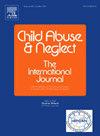The burden of childhood trauma among migrants in psychotherapy treatment in Germany
IF 3.4
2区 心理学
Q1 FAMILY STUDIES
引用次数: 0
Abstract
Background
While there is empirical evidence that migrants often have traumatic experiences before, during and after migration, little is known to date about the extent to which they were affected by childhood trauma in their country of origin.
Objective
The aim of this study was to investigate experiences of abuse and neglect in the childhood of adult migrants undergoing psychotherapy in Germany.
Participants and setting
A total of 106 patients undergoing day clinic treatment at a psychosomatic clinic participated in the study. Half of them had their own migration experience, while the other half, serving as a comparison group, consisted of German patients.
Methods
The severity of trauma symptoms, depression, anxiety, and somatic symptoms was assessed using scales for self-report and for rating by the patients' therapists. The self-report scales were presented in several languages. Evidence of trauma was retrospectively assessed by the therapists using checklists for traumatic experiences in both adulthood and childhood.
Results
The migrant group scored higher on all psychopathology scales and showed more frequent evidence of lifetime trauma than the comparison group. Regarding childhood trauma, emotional abuse and neglect were prevalent in both groups, while physical abuse and neglect, as well as sexual abuse, were more common in the migrant group. Logistic regressions showed that membership in the migrant group was the strongest predictor of physical abuse and neglect, while sexual abuse was more strongly associated with sociodemographic factors.
Conclusions
In psychotherapy for patients with a migration background, all subtypes of childhood trauma should be considered.
德国心理治疗中移民儿童创伤的负担
虽然有经验证据表明,移徙者在移徙之前、期间和之后往往有创伤经历,但迄今为止,人们对他们在原籍国受到童年创伤影响的程度知之甚少。目的本研究的目的是调查在德国接受心理治疗的成年移民的童年虐待和忽视经历。参与者和环境共有106名患者在心身诊所接受日间门诊治疗。其中一半有自己的移民经历,而另一半则由德国患者组成,作为对照组。方法采用创伤症状、抑郁、焦虑和躯体症状的严重程度自述量表和治疗师评定量表进行评估。自我报告量表以几种语文提出。创伤证据由治疗师使用成年期和儿童期创伤经历清单进行回顾性评估。结果移民组在各项精神病理量表上得分均高于对照组,出现终身创伤的证据也较对照组多。关于童年创伤,情感虐待和忽视在两个群体中都很普遍,而身体虐待和忽视以及性虐待在移民群体中更为常见。逻辑回归显示,移民群体的成员身份是身体虐待和忽视的最强预测因子,而性虐待与社会人口因素的关联更强。结论对移民背景的儿童创伤患者进行心理治疗时,应综合考虑其所有亚型。
本文章由计算机程序翻译,如有差异,请以英文原文为准。
求助全文
约1分钟内获得全文
求助全文
来源期刊

Child Abuse & Neglect
Multiple-
CiteScore
7.40
自引率
10.40%
发文量
397
期刊介绍:
Official Publication of the International Society for Prevention of Child Abuse and Neglect. Child Abuse & Neglect The International Journal, provides an international, multidisciplinary forum on all aspects of child abuse and neglect, with special emphasis on prevention and treatment; the scope extends further to all those aspects of life which either favor or hinder child development. While contributions will primarily be from the fields of psychology, psychiatry, social work, medicine, nursing, law enforcement, legislature, education, and anthropology, the Journal encourages the concerned lay individual and child-oriented advocate organizations to contribute.
 求助内容:
求助内容: 应助结果提醒方式:
应助结果提醒方式:


